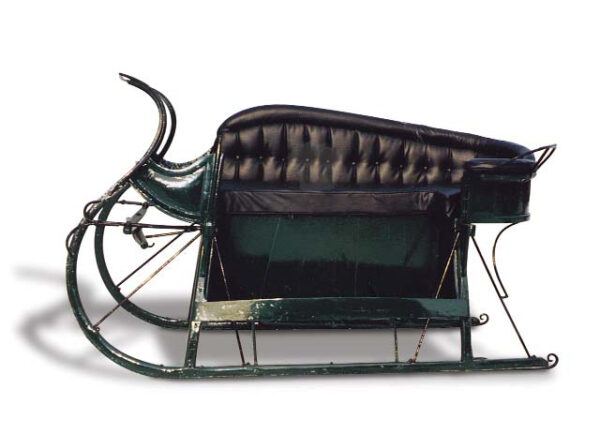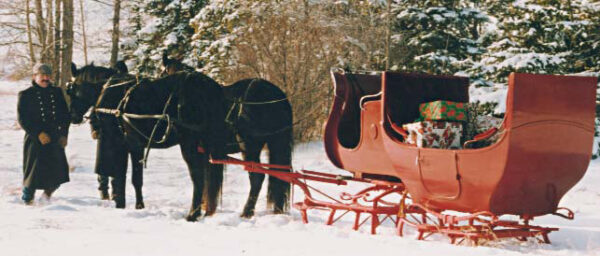
Photo Courtesy of Dr A. F. “Al” Oeming
12 Days of Cowboy Christmas
Dashing Through the Snow
The Romance of Sleighs
By Terri Mason
Whisper quiet and smooth as silk, sleighs have never really gone out of fashion. The mainstay of Christmas carols, seasonal decorations and the most famous teamster of all — Santa — sleighs play an important part in our Christmas pageantry and, as it turns out, our early highway laws and modern automobiles.
Once the premiere mode of winter transportation here in the Canadian West, sleighs enjoyed popularity for many reasons. Sleighs — especially bobsleighs — are very smooth riding. Sleighs are also a comparatively easy pull; one horse can pull eight times as much weight on a sleigh than on a wagon.
Freedom was also a reason; sleighs can travel where there are no roads, and it’s easier to cross a frozen stream in areas where there are no bridges. This ability to travel off the main road to enjoy some privacy translated into a lot of courting over the centuries, aiding in the sleigh’s romantic reputation.
The beauty and the danger of sleighs is their lack of noise. The runners glide noiselessly and the horse’s hoofbeats are muffled by the snow. While this makes for a relaxing ride, it created a safety hazard for unsuspecting pedestrians at the turn of the century. Here on the prairies, Alberta’sfirst Attorney General, J. J. Boyle, made the use of sleigh bells compulsory in 1906, one of our earliest highway traffic act laws.
“Sleigh” is a generic term to cover any vehicle to be pulled through the snow. The most common type of sleigh is a cutter, and the most popular styles include the Portland and the Albany cutter. The vis-à vis (veez ah vee) (literally translates as face-to-face) style sleighs are glamorous and were popular among the wealthier families living in large cities. In rural Canada however, utilitarian vehicles were more practical.
Many automobile companies started as carriage manufacturers and a few, such as Studebaker and McLaughlin, survived the transition from carriage to “horseless carriage.” Some of the terms used for sleigh parts are still evidenced in today’s automobiles; a “dash” is the front of the sleigh and protected the driver from snow and ice kicked up by a “dashing” horse, while the “fenders” protected occupants from sideswiping branches and, for the most part, kept the cold drafts out.
One of the fastest rising social activities is sleigh rallies and cutter parades. Participants gather at a variety of locations; from private farms and ranches to agricultural grounds and enjoy the day dashing through the snow, sipping hot chocolate and visiting. The social rather than competitive aspect of sleigh rallies has dramatically increased this fun winter sport, as well as fuelling driving clinics for novice drivers.
It’s great fun to snuggle under a buffalo robe in a horse-drawn sleigh with the jingle bells ringing. Just don’t forget the hot chocolate — and the mistletoe.
More sleigh resources:
The Remington Carriage Museum in southern Alberta houses the largest collection of horse-drawn vehicles in North America, with over 250 carriages, wagons and sleighs.
Remington Carriage Museum
A: Box 1649, Cardston, Alta T0K 0K0 Phone: (403) 653-5139
W: RemingtonCarriageMuseum.ca
Sleigh reading:
Horse Drawn Sleighs
(Second Edition) by Susan Green
published by The Astragal Press
Mendham, NJ ISBN 1-931626-07-3
(Originally published in Dec2006/Jan2007 edition of Canadian Cowboy Country)

Photo courtesy Remington Carriage Museum

This Albany style vis-à-vis travels on straight runners and is pulled by a team. The driver sits in front and there are two seats in the back facing each other allowing the passengers the opportunity to visit.
Photo courtesy Remington Carriage Museum

Photo courtesy Remington Carriage Museum
















